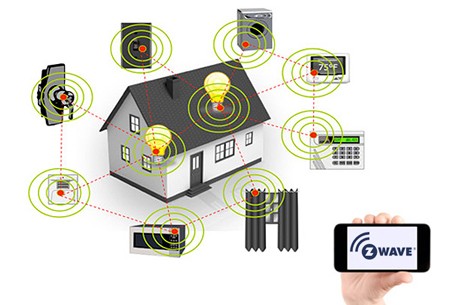Z-Wave is a wireless communication protocol specifically designed for smart home automation systems. It enables devices like lights, locks, thermostats, sensors, and other smart gadgets to communicate with each other seamlessly. Developed by Zensys in 2001 and now maintained by Silicon Labs, Z-Wave has become one of the most popular protocols for connecting and controlling smart devices in homes.
This article explores Z-Wave technology, its features, benefits, and how it differs from other smart home communication protocols like Zigbee and Wi-Fi.
How Z-Wave Technology Works

Z-Wave operates on a low-energy radio frequency (RF) band, typically around 800–900 MHz, which avoids interference with Wi-Fi and Bluetooth that use the 2.4 GHz band. It creates a mesh network where devices communicate with each other rather than relying solely on a central hub. Each Z-Wave device acts as a repeater, relaying signals to other devices, which ensures strong and reliable connections throughout the home.
Key Features of Z-Wave Technology
- Low Power Consumption
Z-Wave is designed to consume minimal power, making it ideal for battery-operated devices like sensors and smart locks. - Mesh Networking
In a Z-Wave network, devices act as nodes that relay signals to one another, extending the network’s range and eliminating dead spots. - Interoperability
Devices that carry the Z-Wave logo are certified to work seamlessly with each other, regardless of the brand or manufacturer. - Range
Z-Wave has a range of about 100 meters (328 feet) in open air, with the mesh network extending this range significantly by allowing signals to hop between devices. - Secure Communication
Z-Wave uses AES-128 encryption to ensure secure communication between devices, making it a reliable choice for home security systems.
Benefits of Z-Wave Technology
1. Easy Integration
Z-Wave devices are designed to be user-friendly, making it simple for homeowners to set up and expand their smart home systems.
2. Broad Compatibility
With over 3,000 certified devices and a wide range of manufacturers supporting Z-Wave, users have plenty of options when selecting devices for their smart home.
3. Reliable Connectivity
The mesh network ensures that signals are strong and consistent, even in larger homes or those with multiple floors.
4. Minimal Interference
By operating on a low-frequency band, Z-Wave minimizes interference with other household wireless technologies like Wi-Fi and Bluetooth.
5. Scalable Systems
A single Z-Wave network can support up to 232 devices, making it suitable for small apartments or large houses.
Applications of Z-Wave Technology
1. Lighting Control
Z-Wave allows users to control lights remotely, schedule on/off times, or adjust brightness levels using a smartphone or voice assistant.
2. Security Systems
Z-Wave-enabled door locks, cameras, and motion sensors enhance home security by enabling remote monitoring and notifications.
3. Climate Control
Smart thermostats with Z-Wave technology allow users to control heating and cooling systems for energy efficiency and comfort.
4. Energy Management
Smart plugs and energy monitors using Z-Wave help track and reduce energy consumption.
5. Leak Detection
Water leak sensors integrated with Z-Wave can alert homeowners to potential leaks, preventing costly damage.
Z-Wave vs. Zigbee vs. Wi-Fi
| Feature | Z-Wave | Zigbee | Wi-Fi |
| Frequency Band | 800–900 MHz | 2.4 GHz | 2.4 GHz / 5 GHz |
| Range | ~100 meters per device | ~10–20 meters per device | Depends on router coverage |
| Power Consumption | Low | Very low | High |
| Interference | Minimal | Potential interference with Wi-Fi | High in congested areas |
| Devices per Network | 232 | ~65,000 | Limited by router capacity |
| Encryption | AES-128 | AES-128 | WPA2/WPA3 |
| Scalability | High | Very high | Medium |
While Zigbee supports more devices per network and consumes less power, Z-Wave has a longer range per device and experiences less interference. Wi-Fi, on the other hand, is ideal for high-bandwidth applications but consumes more power and suffers from congestion in crowded networks.
Setting Up a Z-Wave Smart Home System
1. Choose a Z-Wave Hub
The hub acts as the central controller for all Z-Wave devices. Popular Z-Wave hubs include those from SmartThings, Aeotec, and Vera.
2. Select Compatible Devices
Look for Z-Wave-certified devices that suit your needs, such as light switches, sensors, and smart locks.
3. Install and Pair Devices
Follow the manufacturer’s instructions to install and pair each device with your hub.
4. Customize Automations
Use the hub’s app to set up routines and automations, such as turning on lights when motion is detected or locking doors at night.
Challenges of Z-Wave Technology
1. Cost
Z-Wave devices tend to be more expensive than Wi-Fi-based alternatives due to their specialized design and certification process.
2. Limited Bandwidth
Z-Wave is not suitable for high-bandwidth applications like video streaming or data-heavy devices.
3. Regional Frequency Differences
Z-Wave operates on different frequencies in various regions, so devices purchased in one region may not work in another.
Future of Z-Wave Technology
Z-Wave technology continues to evolve, with a focus on improved security, extended range, and better energy efficiency. The introduction of Z-Wave Long Range (Z-Wave LR) is a significant development, offering a 4x increase in range and support for up to 4,000 devices on a single network. This innovation ensures that Z-Wave remains a competitive and reliable choice for smart home applications.
Conclusion
Z-Wave technology is a cornerstone of smart home automation, offering reliable, secure, and energy-efficient communication for a wide range of devices. Its mesh networking capabilities and broad compatibility make it a popular choice for homeowners looking to create a connected and convenient living space. While it faces competition from protocols like Zigbee and Wi-Fi, Z-Wave’s unique advantages, such as minimal interference and robust security, ensure its continued relevance in the evolving smart home landscape.
By understanding the features and benefits of Z-Wave, you can make informed decisions about integrating this technology into your smart home system.

